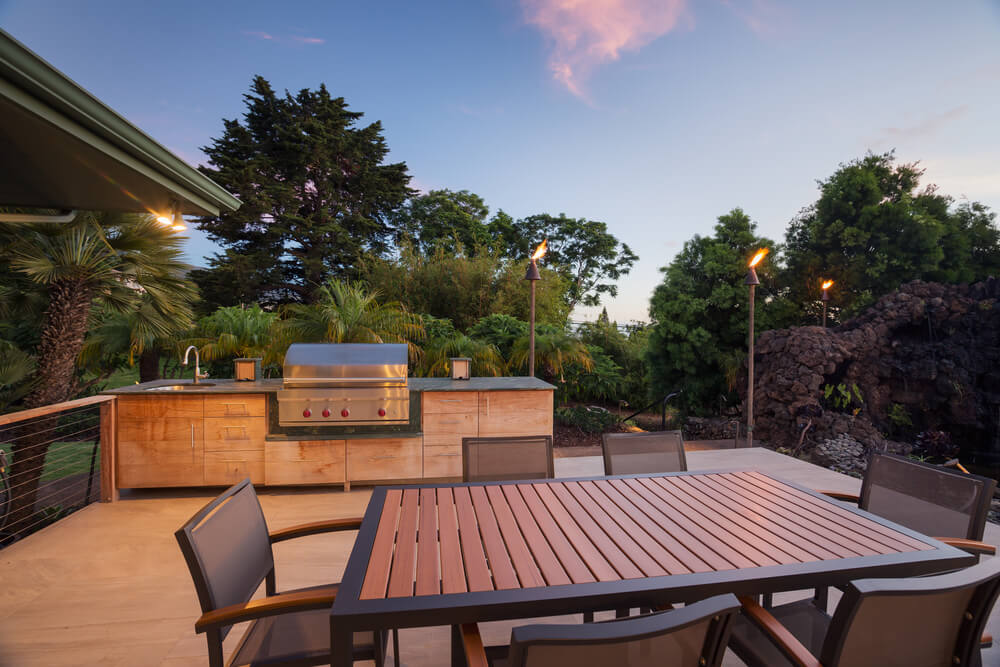
Just because summer is coming to an end doesn’t mean that your outdoor kitchen usage has to come full stop. The exceptional cooking experience that comes with using your open-air kitchen can be enjoyed year-round, and a few simple modifications will add resiliency to your outdoor food space that will cultivate your cooking experiences all year long.
Make Way for Shade
Setting up your outdoor kitchen under an outside structure such as a pergola, canopy, or underneath your home’s overhang provides shade in hotter weather and protection during colder months. A covering for your outdoor kitchen will also protect it from the elements no matter the time of year, which will lengthen the lifespan of all of your appliances and fixtures.
Cooking underneath a covering is a much more pleasurable experience as well, and having protection from the sun and rain will make cooking and eating outdoors something that you’ll want to do as much as possible.
Weatherproofing is Critical
Choosing kitchen equipment that can withstand all forms of weather is vital for a functional outside kitchen that can be used year-round, and rust-proof and easy-to-clean appliances, storage, and finishes work best.
Weatherproof outdoor kitchen cabinets, like those made from marine-grade high-density polyethylene (HDPE), are well-suited for harsh year-round conditions. In addition to investing in weatherproof kitchen gear, covering large appliances when not in use can also provide an extra layer of protection.
Install a Few Basic Environmental Controls
Cooking outdoors quickly leads to eating outdoors, and this means that climate control for those that choose to dine al-fresco can make or break the success of gatherings. Simple additions can provide your guests with instant comfort on a hot or cold day with items such as heat lamps, overhead or wall-mounted patio heaters, and ceiling-mounted fans.
In warmer months, having a few bug-repelling lanterns, insect repellent incense sticks, or growing an herb garden will help keep your outdoor kitchen bug-free. Plants such as lavender, lemongrass, and chrysanthemums also deter insects, and eco-friendly solutions like essential oils and even vinegar and water will help block ants and bees from making your outdoor kitchen their new home.
Even Though You’re Outside, You’ll Need Extra Lighting
Although the sun provides plenty of light during the day, once night falls, on overcast days, or when the days become shorter, more lighting will be necessary. Mood lighting is easy to add with string lights that can be weaved through a pergola, attached to an overhang, or pretty much placed anywhere you’d like without a professional’s help. LED lights can be used, but commercial-grade globe bulbs will add more light to your space.
If you decide to install light fixtures, a ceiling fan with a light is a great way to keep your guests, and anyone cooking cool and bring light your eating area simultaneously. One of the most popular light enhancements that can be seen in outdoor kitchens are beautiful chandeliers, which add both light and dimension to outdoor areas.
Design Your Outdoor Kitchen With Your Local Weather in Mind
Your great escape could be in your very own backyard but maximizing the usage of outdoor kitchens requires planning. Preparing to brave the cold is not as crucial for areas with year-round sunshine and only cooler months. For those that live in much colder climates, an outdoor kitchen encasement that will keep snow and ice out is an excellent way to go.
Preparing your favorite dishes outside without having to worry about spills is only part of what makes open-air cooking so enjoyable, and homeowners can now take advantage of cooking outdoors no matter the time of year.
